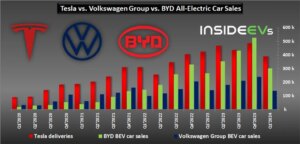The Rise of China’s Auto Industry: A Clash of Titans in Electric Vehicles

At Extreme Investor Network, we understand the evolving dynamics of the global auto market, especially as it pertains to electric vehicles (EVs). As we dive into the numbers and the competitive landscape, it’s evident that China’s automotive sector is rewriting the playbook for both production and exports.
A New Era of Auto Exports
China officially became the world’s largest car exporter in 2023, driven by the rapid rise of affordable EV manufacturers like BYD and Chery. Fast forward to Q1 2025, and Chinese brands have achieved a staggering 69.4% market share in domestic passenger vehicles. This trend reflects China’s unwavering commitment to innovation and technological advancement within its automotive industry.
BYD Takes the Lead
In a noteworthy shift, BYD surpassed Tesla, not just in terms of vehicle sales, but in overall revenue for the first time in 2024, generating an impressive $107 billion, marking a 29% year-over-year growth. The strong performance can be attributed to a 40% increase in both battery electric and hybrid vehicle sales. Comparatively, Tesla managed to achieve a revenue of $97.7 billion with a modest 0.95% YoY growth.
As of 2024, BYD exported 4.27 million vehicles, overshadowing Tesla’s 1.79 million sales. The competition isn’t merely about sales figures; it reflects a larger narrative about technological superiority and market adaptability.
A Global Perspective: Exports and Competitive Edge
China’s global automotive expansion is astonishing. In 2024, the country exported 5.86 million vehicles, a significant 19.3% increase from the previous year. The key markets included Mexico, Russia, Brazil, and the UAE, with passenger vehicle exports reaching 4.96 million and nearly 1 million battery-electric vehicles (BEVs) being sold abroad.
By contrast, Japan, the world’s second-largest auto exporter, shipped 4.22 million vehicles in 2024, reflecting a decline of 4.5% from 2023. Toyota continues to lead the way in Japan, accounting for approximately $312.28 billion in revenue.
Germany, holding onto its third-place title, exported 3.4 million vehicles, marking a 2.5% increase year-over-year. A notable 25.9% of these were electric, with the Volkswagen Group generating $354.86 billion in revenue. The statistics tell a compelling story: while these traditional automotive giants maintain substantial revenues, they face increasing pressure from their Chinese counterparts.
The Technological Edge
The secret sauce behind China’s automotive success isn’t just low prices—it’s also about technological innovation and superior production capabilities. As of February 2025, Chinese automakers accounted for 27.5% of total global auto sales. These vehicles not only come with competitive pricing but often feature advanced technologies that make them appealing to consumers worldwide.
Internationally, there is growing concern regarding the perceived unfair advantages enjoyed by Chinese car manufacturers. The Chinese government has injected significant capital into these companies, allowing them to reduce costs and, in many cases, undercut competitors. With labor costs significantly lower than those in countries like Germany and the US, combined with a self-sufficient supply chain that minimizes reliance on imported parts, Chinese brands have a clear competitive edge.
The Future Looks Bright (and Electric)
As we progress deeper into 2025 and beyond, the global automotive landscape will continue to evolve. Expect more aggressive strategies from Chinese companies and increased competition in the EV sector. Traditional powerhouses will need to innovate and adapt rapidly or risk falling behind.
At Extreme Investor Network, we’ll keep you informed about these developments. By understanding the forces at play, from policy changes to technological advancements, you’ll be better equipped to navigate the opportunities and challenges in the rapidly changing world of automotive investments. Stay tuned as we bring you the latest insights and analysis!

